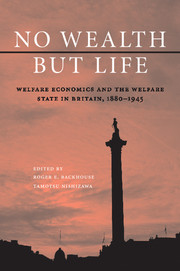Book contents
- Frontmatter
- Contents
- Contributors
- Preface
- 1 Introduction: Towards a Reinterpretation of the History of Welfare Economics
- I CAMBRIDGE WELFARE ECONOMICS AND THE WELFARE STATE
- II OXFORD ETHICS AND THE PROBLEM OF WELFARE
- III WELFARE ECONOMICS IN THE POLICY ARENA
- IV POSTSCRIPT
- 11 Welfare Economics, Old and New
- Index
- References
11 - Welfare Economics, Old and New
Published online by Cambridge University Press: 06 July 2010
- Frontmatter
- Contents
- Contributors
- Preface
- 1 Introduction: Towards a Reinterpretation of the History of Welfare Economics
- I CAMBRIDGE WELFARE ECONOMICS AND THE WELFARE STATE
- II OXFORD ETHICS AND THE PROBLEM OF WELFARE
- III WELFARE ECONOMICS IN THE POLICY ARENA
- IV POSTSCRIPT
- 11 Welfare Economics, Old and New
- Index
- References
Summary
INTRODUCTION
In the 1930s, economists turned to the task of developing welfare economics on non-utilitarian foundations. This was both narrowing and broadening. It narrowed welfare economics in that the assumptions underlying the ‘New welfare economics’ of Hicks, Kaldor and their colleagues made it hard to go beyond the extremely restrictive confines of what became known, after Little (1950), as Pareto-efficiency or Pareto-optimality. The attempt to go beyond this using compensation tests was a failure. However, though this was not immediately apparent, certain ideas within the New Welfare Economics had the potential to broaden the study of welfare, through providing frameworks within which alternative ethical frameworks could be analysed. Abram Bergson (1938) introduced the concept of a social welfare function, writing social welfare as a completely general function of goods and services supplied or consumed by all agents – we might say, as a function of a complete description of the state of the world. In itself, such a social welfare function had no content, for it was too general, but it provided a framework for exploring the implications of different value judgements.
An even more formal approach was introduced by Kenneth Arrow (1951), whose social welfare function took a different form. It was a mapping from the set of individuals' orderings of all possible states of the world to a social ordering. As with Bergson's social welfare function, it was possible to explore restrictions stemming from different ethical judgements.
- Type
- Chapter
- Information
- No Wealth but LifeWelfare Economics and the Welfare State in Britain, 1880–1945, pp. 223 - 236Publisher: Cambridge University PressPrint publication year: 2010
References
- 2
- Cited by



